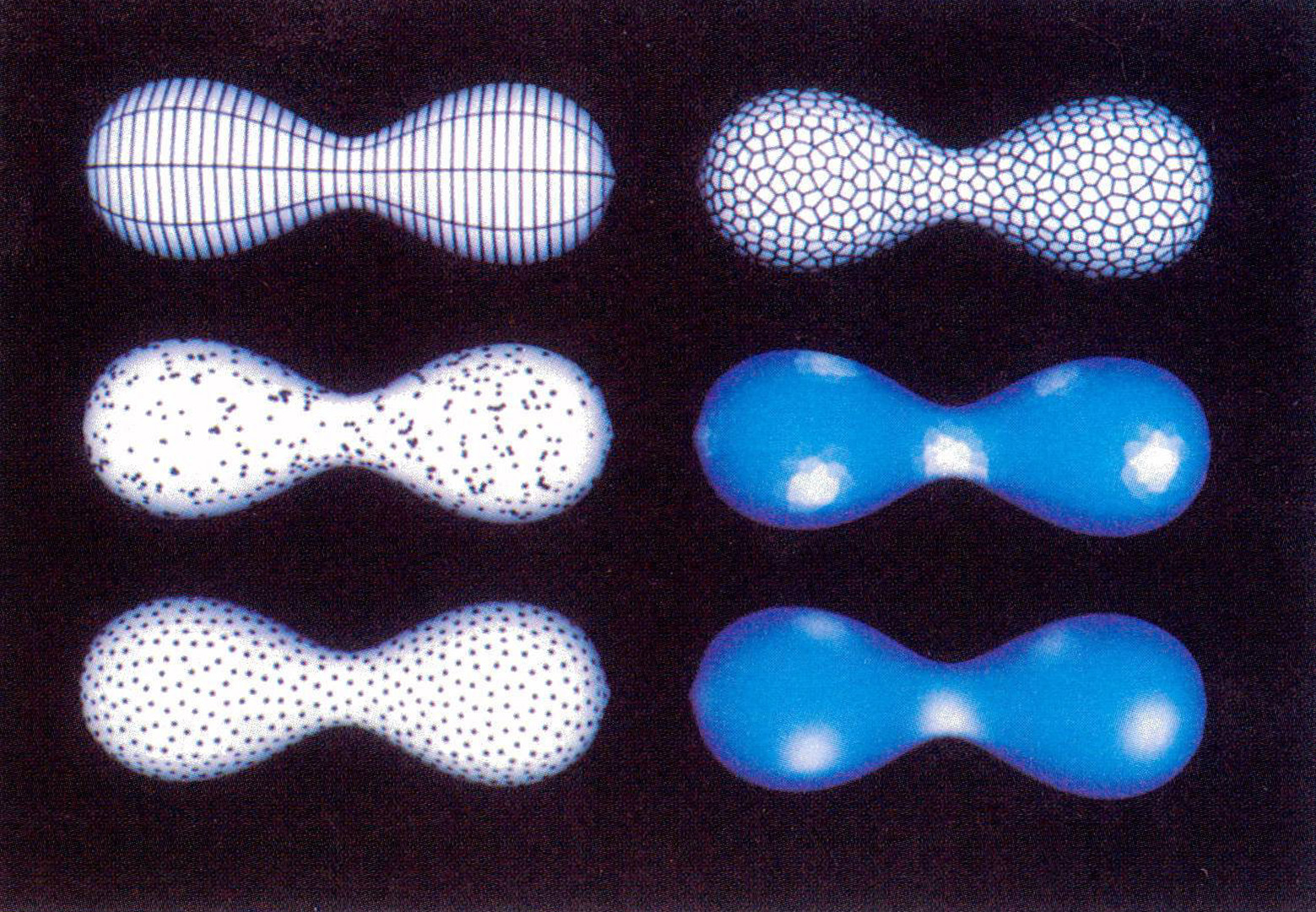“Generating textures on arbitrary surfaces using reaction-diffusion”
Conference:
Type(s):
Title:
- Generating textures on arbitrary surfaces using reaction-diffusion
Presenter(s)/Author(s):
Abstract:
This paper describes a biologically motivated method of texture synthesis called reaction-diffusion and demonstrates how these textures can be generated in a manner that directly matches the geometry of a given surface. Reaction-diffusion is a process in which two or more chemicals diffuse at unequal rates over a surface and react with one another to form stable patterns such as spots and stripes. Biologists and mathematicians have explored the patterns made by several reaction-diffusion systems. We extend the range of textures that have previously been generated by using a cascade of multiple reaction-diffusion systems in which one system lays down an initial pattern and then one or more later systems refine the pattern. Examples of patterns generated by such a cascade process include the clusters of spots on leopards known as rosettes and the web-like patterns found on giraffes. In addition, this paper introduces a method which reaction-diffusion textures are created to match the geometry of an arbitrary polyhedral surface. This is accomplished by creating a mesh over a given surface and then simulating the reaction-diffusion process directly on this mesh. This avoids the often difficult task of assigning texture coordinates to a complex surface. A mesh is generated by evenly distributing points over the model using relaxation and then determining which points are adjacent by constructing their Voronoi regions. Textures are rendered directly from the mesh by using a weighted sum of mesh values to compute surface color at a given position. Such textures can also be used as bump maps.
References:
1. Bard, Jonathan, “A Unity Underlying the Different Zebra Striping Patterns,” Journal of Zoology, Vol. 183, No. 4, pp. 527-539 (December 1977).
2. Bard, Jonathan B. L., “A Model for Generating Aspects of Zebra and Other Mammalian Coat Patterns,” Journal of Theoretical Biology, Vol. 93, No. 2, pp. 363-385 (November 1981).
3. Bard, Jonathan and lan Lauder, “How Well Does Turing’s Theory of Morphogenesis Work?,” Journal of Theoretic’al Biology, Vol. 45, No. 2, pp. 501-531 (June 1974).
4. Bier, Eric A. and Kenneth R. Sloan, jr., “Two- Part Texture Mapping,” IEEE Computer Graphics and Applications, Vol. 6, No. 9, pp. 40-53 (September 1986).
5. Blinn, James F., “Simulation of Wrinkled Surfaces,” Computer Graphics, Vol. 12, No. 3 (SIGGRAPH “78), pp. 286–292 (August 1978).
6. Bloomenthal, Jules, “Modeling the Mighty Maple,” Computer Graphics, Vol. 19, No. 3 fSIGGRAPH ’85), pp. 305-311 (July 1985).
7. Catmull, Edwin E., “A Subdivision Algorithm for Computer Display of Curved Surfaces,” Ph.D. Thesis, Department of Computer Science, University of Utah (December 1974).
8. Gardner, Geoffrey Y., “Visual Simulation of Clouds,” Computer Graphics, Vol. 19, No. 3 (SIGGRAPH ’85), pp. 297-303 (July 1985).
9. Hanrahan, Pat and Paul Haeberli, “Direct WYSIWYG Painting and Texturing on 3D Shapes,” Computer Graphics, Vol. 24, No. 4 (SIGGRAPH ’90), pp. 215-223 (August 1990).
10. Heckbert, Paul S., “Fundamentals of Texture Mapping and Image Warping,” M.S. Thesis, Department of Electrical Engineering and Computer Science, University of Califomia at Berkeley (June 1989).
11. Ho-Le, K., “Finite Element Mesh Generation Methods: A Review and Classification,” Computer Aided Design, Vol. 20, No. 1, pp. 27-38 (January/February 1988).
12. Hubel, David H. and Torsten N. Wiesel, “Brain Mechanisms of Vision,” Scientific American, Vol. 241, No. 3, pp. 150– 162 (September 1979).
13. Hunding, Axel, Stuart A. Kauffman, and Brian C. Goodwin, “Drosophila Segmentation: Supercomputer Simulation of Prepattern Hierarchy,” Journal of Theoretical Biology, Vol. 145, pp. 369-384 (1990).
14. Koenderink, Jan J., “The Structure of Images,” Biological Cybernetics, Vol. 50, No. 5, pp. 363-370 (August 1984).
15. Lengyel, Istv~n and Irving R. Epstein, “Modeling of Turing Structures in the Chlorite-Iodide-Malonic Acid-Starch Reaction System,” Science, Vol. 251, No. 4994, pp. 650–652 (February 8, 1991).
16. Lewis, John-Peter, “Texture Synthesis for Digital Painting,” Computer Graphics, Vol. 18, No. 3 (SIGGRAPH ’84), pp. 245-252 (July 1984).
17. Lewis, J. P., “Algorithms for Solid Noise Synthesis,” Computer Graphics, Vol. 23, No. 3 (SIGGRAPH ’89), pp. 263-270 (July 1989).
18. Ma, Song De and Andre Gagalowicz, “Determination of Local Coordinate Systems for Texture Synthesis on 3-D Surfaces,” Eurographics ’85, edited by C. E. Vandoni.
19. Meinhardt, Hans, Models of Biological Pattern Formation, Academic Press, London, 1982.
20. Melhorn, Kurt, Multi-dimensional Searching and Computational Geometry, Springer-Verlag, 1984.
21. Murray, J. D., “On Pattern Formation Mechanisms for Lepidopteran Wing Patterns and Mammalian Coat Markings,” Philosophical Transactions of the Royal Society B, Vol. 295, pp. 473–496.
22. Peachey, Darwyn R., “Solid Texturing of Complex Surfaces,” Computer Graphics, Vol. 19, No. 3 (SIGGRAPH ’85), pp. 279-286 (July 1985).
23. Perlin, Ken, “An Image Synthesizer,” Computer Graphics, Vol. 19, No. 3 (SIGGRAPH ’85), pp. 287-296 (July 1985).
24. Perlin, Ken and Eric M. Hoffert, “Hypertexture,” Computer Graphics, Vol. 23, No. 3 (SIGGRAPH ’89), pp. 253-262 (July 1989).
25. Samek, Marcel, Cheryl Slean and Hank Weghorst, “Texture Mapping and Distortion in Digital Graphics,” The Visual Computer, Vol. 2, No. 5, pp. 313-320 (September 1986).
26. Toffoli, Tommaso and Norman Margolus, Cellular Automata Machines, MIT Press, 1987.
27. Turing, Alan, “The Chemical Basis of Morphogenesis,” Philosophical Transactions of the Royal Society B, Vol. 237, pp. 37-72 (August 14, 1952).
28. Turk, Greg, “Generating Random Points in Triangles,” in Graphics Gems, edited by Andrew Glassner, Academic Press, 1990.
29. Williams, Lance, “Pyramidal Parametrics,” Computer Graphics, Vol. 17, No. 3 (SIGGRAPH ’83), pp. 1-11 (July 1983).
30. Witkin, Andrew and Michael Kass, “Reaction- Diffusion Textures,” Computer Graphics, Vol. 25 (SIGGRAPH ’91).
31. Yeager, Larry and Craig Upson, “Combining Physical and Visual Simulation — Creation of the Planet Jupiter for the Film 2010,” Computer Graphics, Vol. 20, No. 4 (SIGGRAPH ’86), pp. 85-93 (August 1986).




